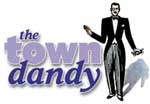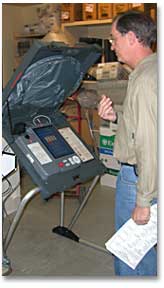|
|
 Roads not traveled |
Dry Run |
DRY RUN: There was just a split-second moment there
when the world fell out from underneath Humboldt County![]()
 Elections
Manager Lindsey McWilliams. McWilliams had taken in a group of
observers to monitor the Logic and Accuracy tests that the elections
department performs on its equipment right before each trip to
the polls. The machines had been primed, the pack of 30 fill-in-the-blank
test ballots had been run through the optical scanner, the computers
whizzed and whirled and counted up the votes. But the results
the computer spit back were not what McWilliams had assured the
observers they would be. No candidate was supposed to receive
more than five votes in the test run, according to McWilliams;
now the computer was saying that some candidates had received
six or even seven.
Elections
Manager Lindsey McWilliams. McWilliams had taken in a group of
observers to monitor the Logic and Accuracy tests that the elections
department performs on its equipment right before each trip to
the polls. The machines had been primed, the pack of 30 fill-in-the-blank
test ballots had been run through the optical scanner, the computers
whizzed and whirled and counted up the votes. But the results
the computer spit back were not what McWilliams had assured the
observers they would be. No candidate was supposed to receive
more than five votes in the test run, according to McWilliams;
now the computer was saying that some candidates had received
six or even seven.
Left: Humboldt County Elections Manager Lindsey McWilliams looks at a Hart eSlate, the new disabled-access voting machines.
An unnerving moment, but McWilliams kept his head. He went back to the pack of test ballots, fanned them out and examined them by hand. Aha! It turned out that the printers of the test ballots had flubbed it. They were supposed to have sent Humboldt County's preferred test suite -- the L&A-5, in which sample candidates receive a maximum of five test votes. Instead, they had sent the L&A-7, in which they receive a maximum of seven. The evidence was set before the observers' eyes. The candidates whom the computers said had received seven votes, had, in fact, received seven votes. All was well. There was a full manual recount of the test ballot, and the county's Diebold machines had passed. Logic and accuracy tests completed.
McWilliams capped the morning with a bonus sneak preview of the Hart eSlate, the new disabled-access voting machines the county recently purchased for around $850,000 in order to comply with the Help America Vote Act. The eSlates, which look like outsized Palm Pilots, allow sight- or mobility-impaired people to cast their votes in privacy. McWilliams gave all the observers a chance to twiddle the eSlate's big dial, and to hear the machine read out the list of candidates up for election in each office. When the observers were done casting their ballot, the machine obligingly printed out a receipt for view before whisking it away into its bowels, there to be retrieved in the event that a hand recount becomes necessary.
Each polling place in the county will have an eSlate available for voters who request it, but McWilliams and Co. are hoping that only voters who really need to use the thing will so request. Tabulation of votes cast on the eSlate is something of a bear for the county elections office at present. The machines don't interface with the Diebold vote-counting software that had been tested that day, and so each ballot cast at the eSlate will be recast by election officials on the regular ballots, then fed in to the system sometime after election day. It's a laborious process, but one McWilliams said the office was happy to undertake if citizens with disabilities choose to use it.
"We're like Burger King here -- you can have it your way," he said.
Rick Barin, an account manager with the Austin, Texas-based company Hart InterCivic, makers of the eSlate, was on hand to prep the gear. He said that he had just been in Lake County, which had purchased the eSlates a bit earlier than Humboldt had. Lake County used the system in the June primary. How many Lake County citizens had used the eSlate then? A grand total of three votes were cast on the machines, he said.
-- Hank Sims
COVER STORY | IN THE NEWS | MEDIA MAVEN | STAGE MATTERS | DIRT | ARTBEAT
TALK OF THE
TABLE | THE HUM | CALENDAR
Comments? Write a letter!
© Copyright 2006, North Coast Journal, Inc.

